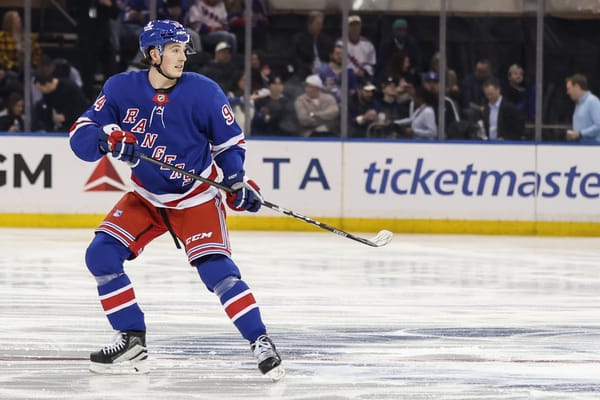Rangers’ Functional Fourth Line Paying Dividends
The Rangers’ fourth line is an under-the-radar benefit of their star power up top.
Ahead of the trade deadline, the New York Rangers added some major star power into their forward ranks, in the form of Vladimir Tarasenko and Patrick Kane. With those players added to a lineup that already includes such forward talent as Mika Zibanejad, Artemiy Panarin, Chris Kreider, Vincent Trocheck, Filip Chytil, Alexis Lafrenière, and Kaapo Kakko, the Rangers are a high-octane group with an emphasis on skill and creativity.
What can get a bit lost in the shuffle is how the bolstered top-nine forward group inherently creates a truly functional and effective fourth line, as solid depth players like Barclay Goodrow and Jimmy Vesey can now serve as luxury fourth-liners instead of playing above what could reasonably be expected of them (i.e., in the top six).
Vesey and Goodrow have joined the re-acquired Tyler Motte to form an excellent fourth line on paper. With the trio now getting some extended run together following Motte’s return from an upper-body injury, that excellence is showing up in on the ice as well.
Up until this point, the Rangers’ fourth line configuration was almost never settled. Ryan Reaves, Sammy Blais, Ryan Carpenter, Jonny Brodzinski, Julien Gauthier, Will Cuylle, and Jake Leschyshyn are all among the players who have gotten fourth-line minutes this season. None are on the current roster. Talk about a lack of stability.
Before, there were too many players getting minutes who were ineffective and/or made you wonder what exactly they were purported to do besides get some good cardio exercise during games. Now, the Rangers have a mainstay fourth line for the rest of the season. Goodrow, Vesey, and Motte work together well, as all play a straightforward, hard forechecking game and are responsible defensively. There is a good combination of physicality, speed, and tenacity, with enough skill to create some offense and finish on some chances, so that they’re not a black hole for scoring like prior iterations of the fourth line.
From a pure production standpoint, this line has already combined for three five-on-five goals in just over 66 minutes of ice time across 12 games. All of the goals have actually come during the past five games, which have seen the Rangers play with a fully healthy forward lineup. As such, this line has gotten more consistent time together rather than some sporadic prior deployment.
For further context: Prior to the consistent usage of this group, Jake Leschyshyn was seeing regular ice time on the Rangers’ fourth line. In just under 105 total five-on-five minutes with Leschyshyn on the ice, the Rangers scored zero goals. It’s nice to now have a fourth line capable of occasional offensive contributions.
With respect to their underlying offensive impact, the Motte-Goodrow-Vesey line — albeit in the somewhat limited sample size of 66 minutes — generates five-on-five expected goals at about a league average rate, per Hockey Viz.
That’s perfectly fine for a fourth line. Beyond that, a closer look shows that a high volume of the chances they do create come in the slot area between the hashes — i.e., in the middle of the most dangerous scoring area. Their tenacity, forechecking, and cycling abilities allow them to get to those high-danger parts of the ice and chip in goals every now and then.
Of course, the Rangers are loaded with firepower on their other forward lines, so their biggest need for their fourth line is to be reliable defensively, in addition to establishing some forechecking pressure to help tire out opponents. A closer look at the defensive impact of the current fourth line illustrates that they are fulfilling their role quite well.
The Rangers concede far fewer high-quality scoring chances with Motte, Goodrow, and Vesey on the ice together; this is both a result of their ability to defend in their own end and their ability to apply pressure in the offensive zone. They are a line head coach Gerard Gallant can trust in various situations, including (and especially) late in games where the Rangers are protecting a one-goal lead.
This fourth line also provides the Rangers with a different look from their other three, skill-heavy lines. While I generally believe that having more skill and creativity is better, I’ve sometimes come across a narrative that the Rangers are too one-dimensional. That perhaps the team doesn’t have enough grinders or physicality to fully succeed deep into the playoffs. I would counter such concerns with the presence and effectiveness of Motte, Goodrow, and Vesey. These three players give the Rangers a good dose of those grinding, physical elements (along with several of the club’s defensemen) while not completely sacrificing skill. They serve as an excellent complement to the rest of the team’s attack.
If the Rangers are to make another deep playoff run, look for this new line to play an integral role.





